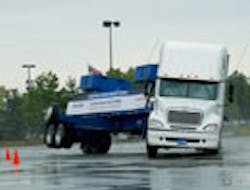A rule that could mandate electronic stability control systems on tractor-trailers has been sent to the White House’s Office of Budget and Management for review.
According to OMB, the office received the proposed rule on Dec. 13, but no details on what’s included in the rule are provided. According to the timeline provided by the National Highway Transportation Safety Administration (NHTSA), the projected publication date in the Federal Register is Dec. 30.
NHTSA issued a notice back on March 18, 2011, indicating that it would be pursuing a possible rule. That notice said the rule would “promulgate a new federal standard that would require stability control systems on truck tractors and motorcoaches that address both rollover and loss of control crashes.”
NHTSA said in the filing that rollover and loss-of-control crashes involving heavy vehicles are responsible for 304 deaths and 2,738 injuries each year. Based on NHTSA data, it believes requiring the devices on heavy vehicles could save up to 66 lives each year and as much as $26 million in property damage per year.
“Our preliminary estimate produces an effectiveness range of 37 to 56% against single-vehicle tractor-trailer rollover crashes and 3 to 14% against loss of control crashes that result from skidding on the road surface,” NHTSA wrote.
While installation of the systems is expensive, NHTSA estimates a positive new benefit of between $128 and $372 million each year due to reduced travel delays and property damage.
NHTSA commissioned a study that was released in 2009 to gauge the effectiveness of stability control systems.
That study concluded that while speed played an important factor in when loss of control (LOC) or rollover might occur, more aggressive advanced safety systems were able to minimize the likelihood of an incident.
“The implication is that the system’s main goal must be to reduce the vehicle speed in order to prevent a negative outcome,” the study reported, noting that roll stability control systems (RSC) were more effective than yaw stability control (YSC) systems on curve events.
“However, when a jackknife did occur, the yaw control applied by the RSC+YSC system was far more effective at keeping the tractor-trailer on or near the road during emergency maneuvers; and the RSC system actually seemed to interfere with the driver’s attempts at maintaining control during the emergency maneuver on snow,” the report said.
The report went on to conclude that the systems were “most effective at providing beneficial interventions in the scenarios that were based on road geometry…In these events, the drivers gradually approached the activation threshold, allowing the system to intervene and counteract the conditions leading to a potential rollover or LOC.
The systems did not perform as well in emergency situations, the report noted. “The emergency
events (right and left incursion) provided a greater challenge to the systems due to the aggressive steering and braking inputs on the part of the driver, resulting in highly dynamic vehicle stability changes. The most dangerous part of the avoidance maneuver seen in these events was the counter-steer input of the driver required to re-enter the desired lane and avoid oncoming or stationary vehicles. The swing of the trailer inertia in the emergency situation on dry road proved very difficult to overcome with the control authority available to the systems.”
The study does conclude that “stability control systems designed to prevent rollover and jackknife in tractor-trailers hold promise for reducing the number of lives lost as well as the cost of damaged property and lost inventory.”
In July, the National Transportation Safety Board recommended stability control systems be installed on all vehicles over 10,000 lbs. Among the recommendations is a directive to the Federal Motor Carrier Safety Administration to mandate the retrofitting of stability-control systems on tanker rigs (with GVWRs over 10,000 lbs.) and having the National Highway Traffic Safety Administration “develop stability control system performance standards for all commercial motor vehicles and buses (with GVWRS over 10,000 lbs.) regardless of whether the vehicles are equipped with a hydraulic or a pneumatic brake system”… and once such [system] performance standards are developed “require the installation of stability control systems on all newly manufactured commercial vehicles (with GVWRs above 10,000 lbs.).”
